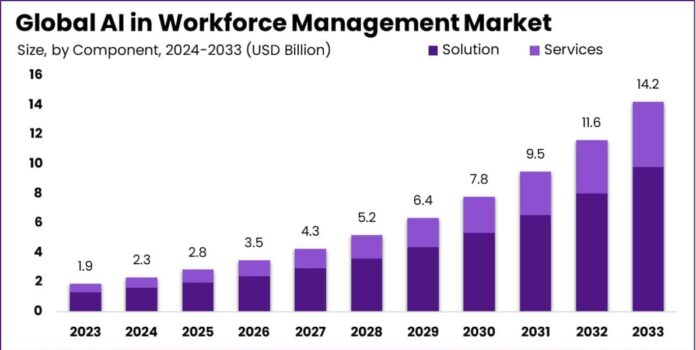The AI-powered workforce management market is projected to reach nearly USD 14.2 billion by 2033, marking a significant increase in its adoption. North America dominates this growth, with a 36.8% share of the market, fueled by advancements in AI technologies that are transforming workforce management practices.
AI is making a tremendous impact across multiple industries by maximizing efficiency in major areas such as scheduling, employee performance tracking, and predictive analytics. Such innovations streamline the process, make businesses save more money, and improve productivity within the overall workforce.
As such, the applications for AI in workforce management continue to expand as it reshapes how organizations approach human resources and operations. Automation through AI allows businesses to predict what their workforce needs are, how to allocate resources, and reduce human error, which can result in better decision-making, increasing employee satisfaction, and more objective, fairer assessments of a person’s performance or workload.
The AI workforce market is highly dominated by North America, mainly due to the increasing adoption of technology and digital transformation within businesses across the region. Firms are spending more on AI-driven solutions in order to remain competitive in the rapidly evolving market landscape. These technologies are not only about increasing operational efficiency but also about developing a more agile, data-informed workforce capable of responding to changing market demands.
The trend of AI workforce management is likely to grow across the globe as organisations in Europe and Asia-Pacific follow the same strategy to strengthen their operational capabilities. More and more availability of AI tools plus the advancement in machine learning algorithms are poised to drive more market growth.
AI is doing more than improving operational metrics. It is transforming the employee experience, too. The use of AI to predict staffing needs ensures that teams are prepared for fluctuations in workload and can improve job satisfaction and avoid burnout. Moreover, AI can help identify gaps in talent and opportunities for training to create a better-skilled and adaptable workforce.
As the demand for smarter, more efficient workforce solutions increases, the AI-driven workforce management market is expected to grow further, with North America leading the charge. Organizations that adopt AI solutions early will gain a competitive advantage not only by improving their internal operations but also by fostering a more engaged, satisfied, and productive workforce.





